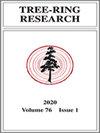A Review of the Current State and Future Prospects of Dendrochronological Research in Bhutan
IF 0.7
4区 农林科学
Q3 FORESTRY
引用次数: 0
Abstract
ABSTRACT The pristine forest of Bhutan offers valuable prospects for dendrochronological research, which involves investigating past weather conditions and examining how trees grow and regenerate to support the development of sustainable forest management practices. This review presents the dendrochronological research conducted in Bhutan using available literature with the aim to determine the potential of tree species for climate or forest ecological studies and to identify gaps by comparing the methodology, collaboration, and prospects. Based on the systematic review of tree-ring research literature and studies conducted in Bhutan from the 2002 to January 2023, the search yielded a total of 36 dendrochronological studies in Bhutan. Bhutan's first tree-ring research publication studied the relationship between three pine ring-width chronologies and temperature. Bhutan's longest-known tree-ring chronology of 638 years (A.D. 1376 to 2013) from Eastern Himalayan spruce (Picea spinulosa) was used for seasonal and annual temperature reconstructions. Many other tree species of temperate conifer and broadleaved forests are continuously being discovered as potential candidates for use in climate and ecology work in Bhutan. Our review identifies that both national and international collaborations are necessary to conduct robust studies spanning different aspects of dendrochronology including dendrogeomorphology, dendroglaciology, dendroentomology, and dendroseismology to contribute to science and informed decision-making.不丹树木年代学研究现状与展望
不丹的原始森林为树木年代学研究提供了宝贵的前景,包括调查过去的天气条件,研究树木如何生长和再生,以支持可持续森林管理实践的发展。本综述利用现有文献介绍了在不丹进行的树木年代学研究,目的是确定树种在气候或森林生态研究中的潜力,并通过比较方法、合作和前景来确定差距。基于对2002年至2023年1月在不丹进行的树木年轮研究文献和研究的系统回顾,该研究在不丹共获得了36项树木年代学研究。不丹的第一份年轮研究出版物研究了三种松树年轮宽度年表与温度之间的关系。不丹最著名的638年(公元1376年至2013年)东喜马拉雅云杉(Picea spinulosa)的树木年轮年表被用于季节性和年度温度重建。许多温带针叶林和阔叶林的其他树种正在不断被发现,作为不丹气候和生态工作的潜在候选者。我们的综述指出,为了开展包括树木地貌学、树木冰川学、树木昆虫学和树木地震学在内的树木年代学的不同方面的强有力的研究,为科学和明智的决策做出贡献,国内和国际合作是必要的。
本文章由计算机程序翻译,如有差异,请以英文原文为准。
求助全文
约1分钟内获得全文
求助全文
来源期刊

Tree-Ring Research
农林科学-林学
CiteScore
2.40
自引率
12.50%
发文量
15
审稿时长
>36 weeks
期刊介绍:
Tree-Ring Research (TRR) is devoted to papers dealing with the growth rings of trees and the applications of tree-ring research in a wide variety of fields, including but not limited to archaeology, geology, ecology, hydrology, climatology, forestry, and botany. Papers involving research results, new techniques of data acquisition or analysis, and regional or subject-oriented reviews or syntheses are considered for publication.
Scientific papers usually fall into two main categories. Articles should not exceed 5000 words, or approximately 20 double-spaced typewritten pages, including tables, references, and an abstract of 200 words or fewer. All manuscripts submitted as Articles are reviewed by at least two referees. Research Reports, which are usually reviewed by at least one outside referee, should not exceed 1500 words or include more than two figures. Research Reports address technical developments, describe well-documented but preliminary research results, or present findings for which the Article format is not appropriate. Book or monograph Reviews of 500 words or less are also considered. Other categories of papers are occasionally published. All papers are published only in English. Abstracts of the Articles or Reports may be printed in other languages if supplied by the author(s) with English translations.
 求助内容:
求助内容: 应助结果提醒方式:
应助结果提醒方式:


